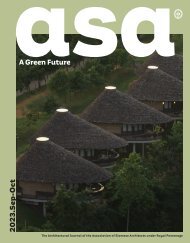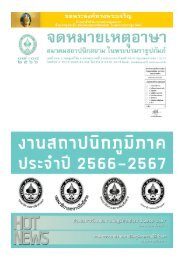ASA CREW VOL.9
E-SAN FUTURE
E-SAN FUTURE
- No tags were found...
Create successful ePaper yourself
Turn your PDF publications into a flip-book with our unique Google optimized e-Paper software.
เรื่อง :<br />
E-SAN<br />
TRAVEL<br />
Back to Origin<br />
เที่ยวไปในตัวตน<br />
ว่ากันว่าการรู้จักตัวตนที่ดีที่สุดคือการย้อนกลับไปทำความรู้จักถึงแหล่งกำเนิด ฉบับนี้เรา<br />
จะพาคุณไปเที่ยวภาคอีสานในอีกแง่มุม ผ่านการเรียนรู้วิถีชีวิตและวัฒนธรรมท้องถิ่นในชุมชน<br />
ยวนสีคิ้ว จังหวัดนครราชสีมา และศูนย์วัฒนธรรมไทย-จีน ศูนย์รวมจิตใจของชาวไทยเชื้อสาย<br />
จีนในจังหวัดอุดรธานี<br />
It is said the best way to know yourself is to go back to learn from the origin. <strong>ASA</strong> <strong>CREW</strong><br />
will take you to visit Isan region (the northeast region) through a different point of view. You will<br />
learn about life style and culture of people in Yuan Sikhio community in Nakorn Ratchasima<br />
province and take a visit at Thai – Chinese culture center in Udonthani province.<br />
วัดของชาวยวนสีคิ้วมีลักษณะโดยรวมคล้ายคลึงกับวัด<br />
ในภาคอีสานทั่วไป โบสถ์รุ่นเก่าแก่ที่สุดที่ปรากฏในชุมชนถูก<br />
ก่อสร้างอย่างเรียบง่ายด้วยงานช่างฝีมือท้องถิ่นผสมผสานกับ<br />
วัฒนธรรมที่หลากหลาย บางแห่งมีการประดับตกแต่งอย่าง<br />
ประณีต บางแห่งยังปรากฏพระธาตุทรงบัวเหลี่ยมแบบอีสาน<br />
และพบคติการบูชารอยพระพุทธบาทและประเพณีการตักบาตร<br />
ด้วยดอกไม้ในวันเข้าพรรษา ซึ่งเกี่ยวพันกับประเพณีของเมือง<br />
สระบุรี นอกจากนี้ยังปรากฏร่องรอยความเชื่อดั้งเดิมเกี่ยวกับ<br />
สิ่งลึกลับเหนือธรรมชาติแทรกตัวอยู่ในชุมชนวัฒนธรรมแห่งนี้<br />
อย่างแนบแน่น<br />
ชุมชนยวนสีคิ้วจึงเป็นตัวอย่างหนึ่งของชุมชนชาติพันธุ์<br />
ในความเป็นพหุสังคมของภาคอีสาน นอกเหนือจากการเรียน<br />
รู้ผ่านงานสถาปัตยกรรมพื้นถิ่นและสิ่งแวดล้อมสรรสร้างใน<br />
ชุมชนแล้ว การสัมผัสวิถีชีวิตของผู้คนในท้องถิ่นที่สื่อสารกัน<br />
ด้วยภาษาไทยถิ่นเหนือ แต่งกายด้วยผ้าทอพื้นเมือง และ<br />
สืบทอดประเพณีวัฒนธรรมดั้งเดิมภายใต้ความผสมผสาน<br />
ระหว่างวัฒนธรรมภาคอีสานและภาคกลางยังเป็นองค์ประกอบ<br />
สำคัญที่จะช่วยสร้างความประทับใจและประสบการณ์ที่ดีให้<br />
แก่นักเดินทางผู้มาเยี่ยมเยือนชุมชนแห่งนี้<br />
When Yuan people migrated into the area, they brought<br />
Yuan-Sikhio Community<br />
ชุมชนยวนสีคิ้ว : ร่องรอยล้านนาในแดนโคราช<br />
ชุมชนยวนสีคิ้วเป็นชุมชนของประชากรกลุ่มชาติพันธุ์ไต<br />
ยวน ซึ่งตั้งอยู่ในเขตอำเภอสีคิ้ว จังหวัดนครราชสีมา บรรพ<br />
ชนของคนกลุ่มนี้สืบเชื้อสายมาจากชาวยวนเมืองเชียงแสน<br />
(ในเขตจังหวัดเชียงราย) ซึ่งย้ายเข้ามาตั้งถิ่นฐานในบริเวณ<br />
ลุ่มน้ำลำตะคอง เขตอำเภอสีคิ้ว ในสมัยรัชกาลที่2 แห่งกรุง<br />
รัตนโกสินทร์ ชุมชนแห่งนี้จึงมีวัฒนธรรมบางประการที่แตก<br />
ต่างจากสังคมแวดล้อมในภาคอีสาน รวมถึงปรากฏร่องรอย<br />
ทางสถาปัตยกรรมและสิ่งแวดล้อมสรรสร้างที่โดดเด่น แม้ว่า<br />
จะดำรงอยู่ร่วมกันกับผู้คนในพื้นที่ชายขอบระหว่างภาคกลาง<br />
และภาคอีสานมายาวนานร่วม 200 ปี ในฐานะชุมชน “หน้า<br />
ด่าน” และ “ทางผ่าน”<br />
แต่เดิมพื้นที่บริเวณอำเภอสีคิ้วถือเป็นเขตชายป่าดง<br />
พญาไฟที่ทุรกันดาร และมีภูมิประเทศเป็นที่ลาดเชิงเขาจึงไม่<br />
เอื้อต่อการตั้งถิ่นฐานเป็นชุมชนเกษตรกรรมมากนักเมื่อชาว<br />
ยวนเข้ามาบุกเบิกที่ท ำกินในบริเวณนี้ได้นำภูมิปัญญาเหมือง<br />
ฝายและระหัดวิดน้ำเข้ามาพัฒนาเครือข่ายชลประทาน และ<br />
ขยายพื้นที่เพาะปลูกให้กว้างขวางมากขึ้น จนสามารถตั้ง<br />
ถิ่นฐานเป็นชุมชนเกษตรกรรมขนาดใหญ่ได้ ในปัจจุบันยัง<br />
ปรากฏร่องรอยเหมืองฝายโบราณหลายแห่ง ซึ่งมีคุณลักษณะ<br />
ที่สัมพันธ์กับภูมิปัญญาเหมืองฝายของล้านนา รวมถึงพบ<br />
การใช้ระหัดวิดน้ำอย่างแพร่หลายในบริเวณนี้<br />
ที่สำคัญคือลุ่มน้ำลำตะคองในเขตอำเภอสีคิ้ว เป็นพื้นที่<br />
ที่มีระหัดวิดน้ำปรากฏอยู่มากที่สุดในประเทศไทย ความ<br />
ชัดเจนของสิ่งแวดล้อมสรรสร้างทางการเกษตรเหล่านี้ชวนให้<br />
จินตนาการไปถึงระบบการทำนาทดน้ำสมัยโบราณของกลุ่ม<br />
คนผู้พูดภาษาตระกูลไทในเขตภูมิลักษณ์ภูเขาบริเวณตอน<br />
บนของภาคพื้นทวีปอุษาคเนย์<br />
สถาปัตยกรรมพื้นถิ่นในชุมชนยวนสีคิ้วมีเรือนพักอาศัย<br />
ที่ปลูกสร้างตามแบบแผนวัฒนธรรมล้านนา ลักษณะเป็น<br />
“เรือนสองหลังร่วมพื้น” หรือ “เรือนสามหลังร่วมพื้น” วางตัว<br />
เรือนขวางตะวันเป็นเอกลักษณ์ แต่มีความผสมผสานกับ<br />
วัฒนธรรมภาคกลางและท้องถิ่นโคราช จนเกิดเป็นเรือนไต<br />
ยวนที่มีลักษณะโดดเด่น ปัจจุบันยังสามารถพบเห็นเรือนยวน<br />
สีคิ้วแทรกตัวอยู่ในเขตเทศบาลเมืองและหมู่บ้านชนบทต่างๆ<br />
โดยในพื้นที่ชนบทจะปรากฏเรือนเหล่านี้อยู่ท่ามกลาง<br />
บรรยากาศของชุมชนเกษตรกรรมแบบดั้งเดิม ในสมัยหลัง<br />
ชาวยวนสีคิ้วได้นิยมปลูกสร้างบ้านเรือนโดยวางอาคารตาม<br />
แนวตะวัน เพื่อให้สอดคล้องกับคติความเชื่อของคนกลุ่มใหญ่<br />
ในภาคอีสาน แต่ยังคงลักษณะสำคัญบางประการของเรือน<br />
แบบแผนล้านนาเอาไว้ แสดงให้เห็นถึงการปรับตัวเข้ากับ<br />
สังคมใหญ่อย่างยืดหยุ่นของชาวยวนสีคิ้วที่ดำเนินไปควบคู่<br />
กับการธำรงความเป็นตัวตนทางชาติพันธุ์<br />
the knowledge about mining, norias and dams to develop the<br />
irrigation system and expanded area for agriculture. There<br />
are still some wrecks of ancient dams which relate to the<br />
Laan Na dams. Many norias are found in the area as well.<br />
There are most norias along the Lum Takong River<br />
in Sikhio district. These irrigation environments remind<br />
us about the ancient rice farming system of Tai Group<br />
people who lived on the mountains in the northern part<br />
of Southeast Asia<br />
Yuan Sikhio community has its own local architecture<br />
which is residential buildings built in Laan Na style.<br />
Its outstanding character is the cluster of 2-3 houses<br />
connected on the same deck. The house is located<br />
perpendicular to the path of the sun (East-West axis).<br />
But there are some mixtures that blend them with central<br />
region culture and local Korat culture. Nowadays, we<br />
still can see some of these Yuan houses in the Town<br />
Municipality area and in some far villages. Later Yuan<br />
people usually locate their houses along the path of<br />
the sun to follow beliefs of most northeastern people<br />
but their houses still have the unique character of Laan<br />
Na dwellers. This shows that Yuan Sikhio people adapt<br />
themselves into the major society but still maintain their<br />
original identity.<br />
Temples in Yuan Sikhio community are alike other<br />
temples in the northeast region of Thailand. The oldest<br />
temple was built by local craftsmen with mixture of<br />
various cultures. There are some square based pagodas<br />
in Isan style as well. There are some traces of ancient<br />
traditions about showing respect to the Buddha’s foot<br />
print and tradition of giving flowers to monks on Khao<br />
Pansa Day the same as Saraburi’s tradition. And there are<br />
traces of paranormal beliefs in this community as well.<br />
Yuan Sikhio community is one ethnic community<br />
of northeastern people. Visitors will learn not only Yuan’s<br />
local architecture and creative environment, but they<br />
will also experience the local life style with local clothes,<br />
language, and some ancient traditions referring the<br />
combination between central and northeastern cultures<br />
when they come visit this interesting community.<br />
The Yuan-Sikhio Community is the neighborhood<br />
of Tai Yuan ethnic. It locates in Sikhio district, Nakorn<br />
Ratchasima province (Korat). Their ancestors derived<br />
from Yaun people of Chiang San (in Chiang Rai province)<br />
who migrated into Lum Takong Basin in Sikhio district<br />
in the reign of King Rama II.<br />
The Yuan-Sikhio Community is the neighborhood<br />
of Tai Yuan ethnic. It locates in Sikhio district, Nakorn<br />
Ratchasima province (Korat). Their ancestors derived<br />
from Yaun people of Chiang San (in Chiang Rai province)<br />
who migrated into Lum Takong Basin in Sikhio district<br />
in the reign of King Rama II. This community has some<br />
different culture from other northeastern people. They<br />
also have unique architecture and environment. Even<br />
though Yuan community has remained in the border<br />
land between the central region and the northeast region<br />
for over 200 years as a gateway, but it still can maintain<br />
its identity including with adaptation to be a part of<br />
Korat society.<br />
Sikhio district in the past was at the edge of Dong<br />
Phaya Fai forest. It was on the foot of the hill where<br />
was not proper for agricultural community.<br />
- 30 -<br />
- 31 -<br />
MAY-APRIL MAY-JUNE 2018 - ISSUE 09<br />
MAY-APRIL MAY-JUNE 2018 - ISSUE 09


















